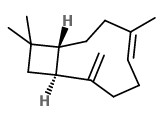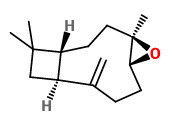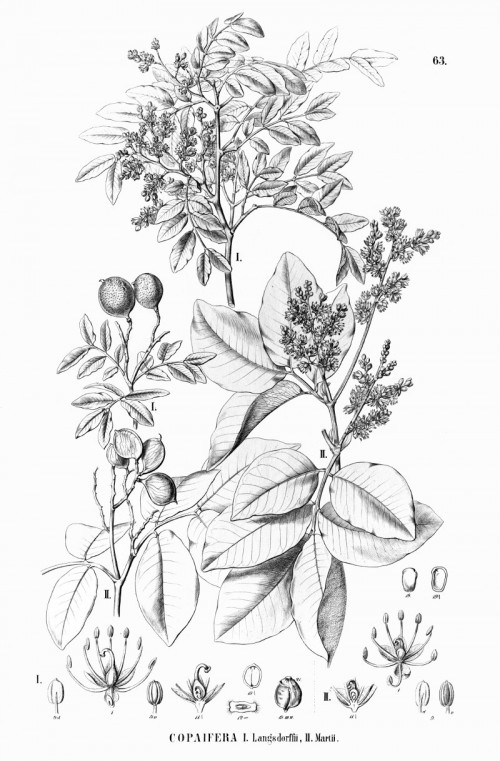Benutzer-Werkzeuge
Copaifera langsdorffii Desf. - Caesalpinioideae - diesel tree
Evergreen tree, up to 20m high, native to South America. The Copaiba oleoresin is obtained from the trunk of several Copaifera L. species.
„The thick, transparent exudate varies in color from light gold to dark brown, depending on the ratio of resin to essential oil. Copaiba is used in making varnishes and lacquers. The balsam may be steam distilled to give copaiba oil, a colorless to light yellow liquid with the characteristic odor of the balsam and an aromatic, slightly bitter, pungent taste. The oil consists primarily of sesquiterpene hydrocarbons; its main component is caryophyllene.“ https://en.wikipedia.org/wiki/Copaiba
 β-caryophyllene |  caryophyllene oxide |
„GC/MS analysis of the hydrodistilled essential oils from leaves, root bark, fruit peel, trunk bark, trunk wood, root wood and fruits of Copaifera langsdorffii Desf. obtained in 0.04%, 0.01%, 0.7%, 0.003%, 0.008%, 0.07% and 0.3% yield, respectively, and also from copaiba balsam (7.3%), allowed the identification of 40 different constituents. The major compounds were: leaf and fruit oils: β-caryophyllene (16.6% and 14.8%) and γ-muurolene (25.2% and 29.8%); fruit peel oil: caryophyllene oxide (47.3%); root wood oil: caryophyllene oxide (40.5%) and 4-α-copaenol (17.6%); root bark oil: caryophyllene oxide (30.7%) and kaurene (8.2%); trunk wood oil: γ-muurolene (8.3%), caryophyllene oxide (31.0%) and kaurene (30.2%); trunk bark oil: β-bisabolol (30.5%), kaurene (16.7%) and kaurenal (31.9%); copaiba balsam oil: β-caryophyllene (53.3%).“
[Volatile constituents of Copaifera langsdorffii from the Brazilian northeast. Gramosa, N. V., & Silveira, E. R., Journal of Essential Oil Research, Vol.17(2), 2005, 130-132]
„A number of studies have shown that CB2 is critically involved in the modulation of inflammatory and neuropathic pain responses. In this study, we have investigated the analgesic effects of BCP [β-caryophyllene] in animal models of inflammatory and neuropathic pain. We demonstrate that orally administered BCP reduced inflammatory (late phase) pain responses in the formalin test in a CB2 receptor-dependent manner, while it had no effect on acute (early phase) responses. In a neuropathic pain model the chronic oral administration of BCP attenuated thermal hyperalgesia and mechanical allodynia, and reduced spinal neuroinflammation. Importantly, we found no signs of tolerance to the anti-hyperalgesic effects of BCP after prolonged treatment. Oral BCP was more effective than the subcutaneously injected synthetic CB2 agonist JWH-133. Thus, the natural plant product BCP may be highly effective in the treatment of long lasting, debilitating pain states. Our results have important implications for the role of dietary factors in the development and modulation of chronic pain conditions.“
[Klauke, A-L., et al. „The cannabinoid CB 2 receptor-selective phytocannabinoid beta-caryophyllene exerts analgesic effects in mouse models of inflammatory and neuropathic pain.“ European Neuropsychopharmacology 24.4 (2014): 608-620] http://www.sciencedirect.com/science/article/pii/S0924977X13003027

Copaifera langsdorffii (I) and Copaifera martii (II)
Martius, C., Eichler, A.G., Urban, I., Flora Brasiliensis, vol.15(2) f.50 t.63 (1870)
http://plantgenera.org/species.php?id_species=272260
